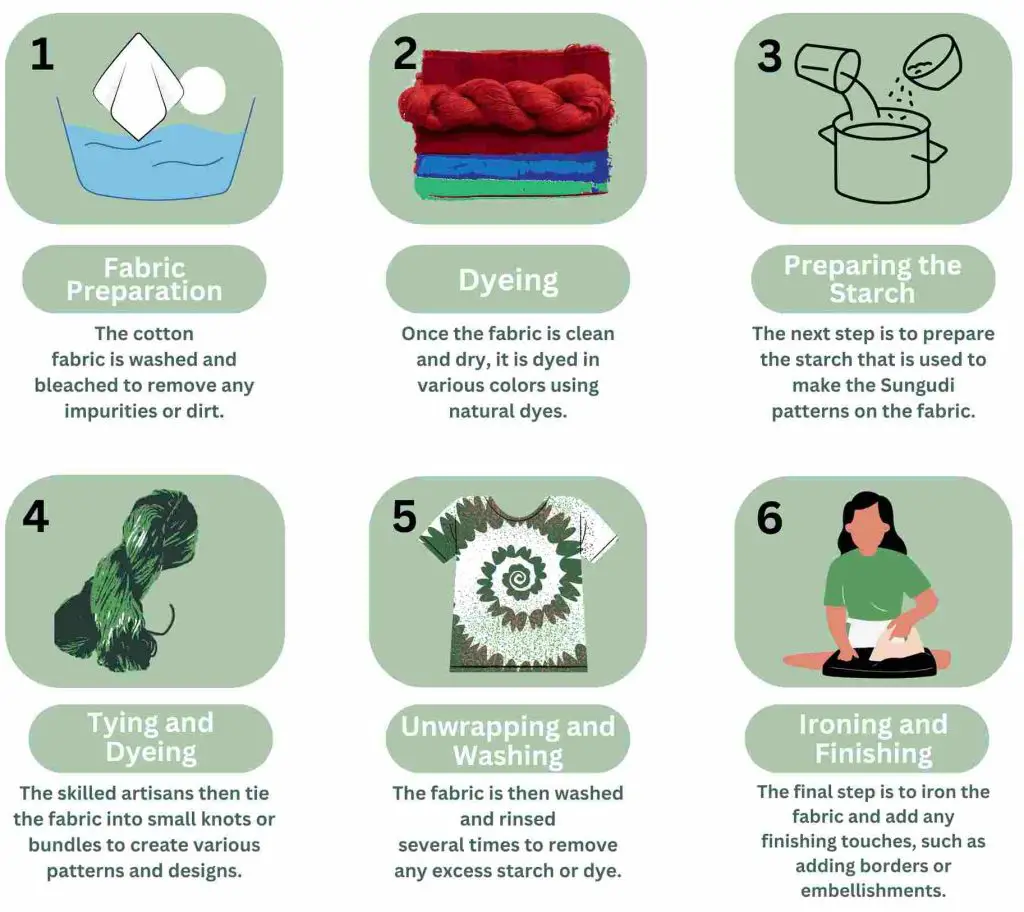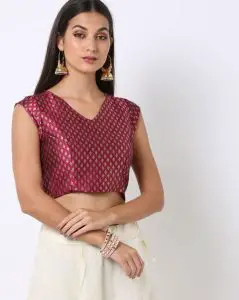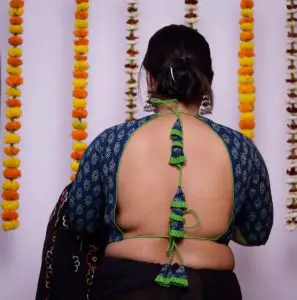Sungudi Sarees are traditional cotton sarees from the Tamil Nadu village of Chinnalapatti, distinguished for its block prints and tie-dye patterns. They are also known as the “Madhurai saree,” and the “Chinnalapattu”.
In Saurashtra, the word ‘sungudi’ derives from the Sanskrit word ‘sunnam’, which means ’round,’ and refers to the conspicuous and distinctive motif of round dots painted on the cloth.
The saree is recognised for its lightweight, silky texture and beautiful zari embroidery, which gives it an attractive and classic appearance. This article examines the history of the Sungudi saree, the techniques used to manufacture it, and its current popularity.
WHERE IS SUNGUDI SAREE FAMOUS? [SUNGUDI SAREES HISTORY]
During the reign of the Nayak Dynasty, Sourashtrian weavers moved from Gujarat and settled in Madurai. These weavers were accomplished craftsmen. The women were experts in tying, while their males were adept at dying.
After settling in Madurai, they chose to give their rich tie-dye tradition a new meaning by infusing their technique with local influences. The pattu-nool-karars integrated the tie-and-dye technique when designing the sungudi sarees that are Madurai’s hallmark fabric.
According to legend, Madurai’s women were the inspiration for Sungudi sarees. The weavers made spherical designs on the cloth that resembled a bun, inspired by the way the women of Madurai knotted their hair. They grabbed little amounts of fabric and fastened it with threads. The cloth was then submerged in containers of natural colours.
When the cloth was untied, the knotted sections retained their original colour while the remainder of the fabric absorbed the dye. The resulting arrangement of dots resembled stars dispersed over the night sky.
Thus, some think that the sungudi patterns were influenced by astronomical stars, which resulted in the development of these circular motifs.
Once each knot is untied, the classic elegance of the dotted motifs and the understated beauty of the surface decoration created by the sungudi art are exposed. It mixes a traditional method with modern patterns and aesthetics.
HOW IS SUNGUDI SAREE MADE? [THE ART OF TIE AND DYE]

The making process of Sungudi saree is an intricate and detailed process that involves skilled artisans using traditional techniques to create beautiful patterns and designs on the fabric.
- Fabric Preparation: The first step in making a Sungudi saree is to prepare the fabric. Usually, pure cotton fabric is used to create Sungudi sarees. The cotton fabric is washed and bleached to remove any impurities or dirt.
- Dyeing: Once the fabric is clean and dry, it is dyed in various colors using natural dyes. These dyes are extracted from natural sources like flowers, leaves, and roots, and are eco-friendly and non-toxic.
- Preparing the Starch: The next step is to prepare the starch that is used to make the Sungudi patterns on the fabric. A mix of rice and water is boiled until it thickens, forming a sticky paste-like consistency. This starch is then cooled and kept aside.
- Tying and Dyeing: The skilled artisans then tie the fabric into small knots or bundles to create various patterns and designs. These knots are called ‘Kattam’ in Tamil. The fabric is then dipped into the starch mixture and left to dry in the sun. The tied sections of the fabric resist the dye, creating a beautiful pattern on the fabric.
- Unwrapping and Washing: Once the fabric is dry, the artisans untie the knots, revealing the beautiful Sungudi patterns. The fabric is then washed and rinsed several times to remove any excess starch or dye.
- Ironing and Finishing: The final step is to iron the fabric and add any finishing touches, such as adding borders or embellishments.
MAINTENANCE OF SUNGUDI SAREE
In addition to their sturdiness, sarees with a Sungudi pattern are also low-maintenance. They can be washed either by hand or in a washing machine and it is recommended to dry them in a shady area rather than tumble drying.
THE REGIONAL VARIATIONS OF SUNGUDI SAREES
Sungudi sarees come in different regional variations, with each region having its unique style and design. The sarees of Madurai, for instance, are renowned for their bright colours and big patterns, while those of Sivakasi are praised for their muted tones and delicate embroidery.
WHEN TO WEAR SUNGUDI SAREES?
Women enjoy wearing the dual-dyed Sungudi saree to special events like weddings and other cultural celebrations. Because of their inexpensive price, these sarees are sometimes used as alternatives to more expensive sarees. These sarees are perfect for any formal event, whether it’s a business meeting, a wedding, an auspicious occasion, or a party.
THE MAGNIFICENCE OF THE SUNGUDI SAREE
A flawless sungudi saree embodies the art of elegance via its effortless combination of grace, beauty, and ease. Traditional sungudi saree colours include crimson, olive green, yellow, and blue.
The borders and end parts of a traditional sungudi saree are often a different colour from the rest of the fabric. The borders typically have a zari design made with contrasting warp threads.
The main feature of sungudi saree is that they are very light-weighted and easy to drape. When combined with gold jewellery, these sarees appear just as elegant as the more expensive Kanjeevaram and Ikkat sarees from Pochampalley and Odisha, but at a fraction of the cost.
SUNGUDI SAREE BLOUSE DESIGNS
Sungudi sarees are versatile and can be paired with different types of blouses to create a variety of looks such as:
- Boat Neck Blouse:

Source: jiomart
- V-Neck Blouse:

Source: jiomart
- Backless Blouse:

source: gounique
- Collared Blouse:

source: kalkifashion
SUNGUDI SAREE PRICE RANGE
Generally, the price of a cotton Sungudi saree starts from around INR 500 and can go up to INR 3000 or more and cotton-silk Sungudi sarees are priced between INR 1500 to INR 5000. While silk sungudi sarees are more expensive, with prices ranging from INR 2000 to INR 10,000 or more, depending on the quality of the silk and the intricacy of the design.
WHERE TO BUY SUNGUDI SAREE ONLINE?
- Amazon
- Meesho
- Etsy
- Myntra
- Fashionous
- Aishwaryam Textiles
- Sobaggu
- Vika Boutique
- Knot ‘n’ Threads
- Desicallyethnic
- Sundaram Saree
- Vannamayil
- SasthaTrends
LATEST TRENDS OF SUNGUDI SAREE
Despite changing fashion trends, Sungudi sarees have remained popular among women of all ages. In recent years, the growing demand for sustainable and eco-friendly fashion has further boosted the popularity of Sungudi sarees in the fashion industry.
The Tamil Nadu government has played a crucial role in promoting this traditional craft through various marketing programs and strategies, increasing awareness of the unique heritage and craftsmanship of Sungudi sarees.
They have exempted the sale of Sungudi fabric from the levy of sales tax since 1959, further encouraging the cottage industry and making the sarees more affordable for consumers. As a result, the demand for Sungudi sarees has grown not only in India but also in other countries such as Singapore, Malaysia, Sri Lanka, and South Africa.
Sungudi sarees are also celebrated annually on 8th February, known as Sungudi Day, to honor the legacy of this ancient handcrafting skill. The art of tying and dyeing the fabric has been passed down over generations, making it a symbol of regional identity and a cultural signifier of Tamil Nadu.







